This event was very favourably placed for New Zealand, with the updated path crossing much of the South Island and the southern North Island. The updated prediction was expected to be very accurate.
Definite occultations were recorded by Gordon and Rick Hudson using video at the Kotipu Place Observatory in Pukerua Bay and by Alan Gilmore using the photometer at Mt John Observatory (MJUO). The event was also monitored in Wanganui by Ray Wright with an indeterminate result.
Discussion:
With a predicted magnitude drop of only 0.15 this event was not amenable to naked eye observation. However the occultation was definitely captured by both the Hudsons and Gilmore. The Hudsons were able to successfully extract the occultation data using Limovie software, proving that the video technique is capable of recording very marginal events.
Ray Wright in Wanganui also recorded data using video, but as he runs a Mac and Limovie is not available for the Mac platform, he had no easy way of determining whether the event was captured. With the low delta m of 0.15 the drop in brightness would not have been visible on-screen. Unfortunately the video record was not kept for possible analysis by another observer. In the light of subsequent events this is perhaps unfortunate, as the determination of whether an event was seen at Wanganui would have led to a significantly more useful result.
Kotipu Place Data:
The Kotipu Place data is very noisy (as one would expect for such a difficult event) and has a time resolution of 40 milliseconds per data point. Brian Loader was able to improve the noise and extract the times of occultation by calculating and plotting a running mean:
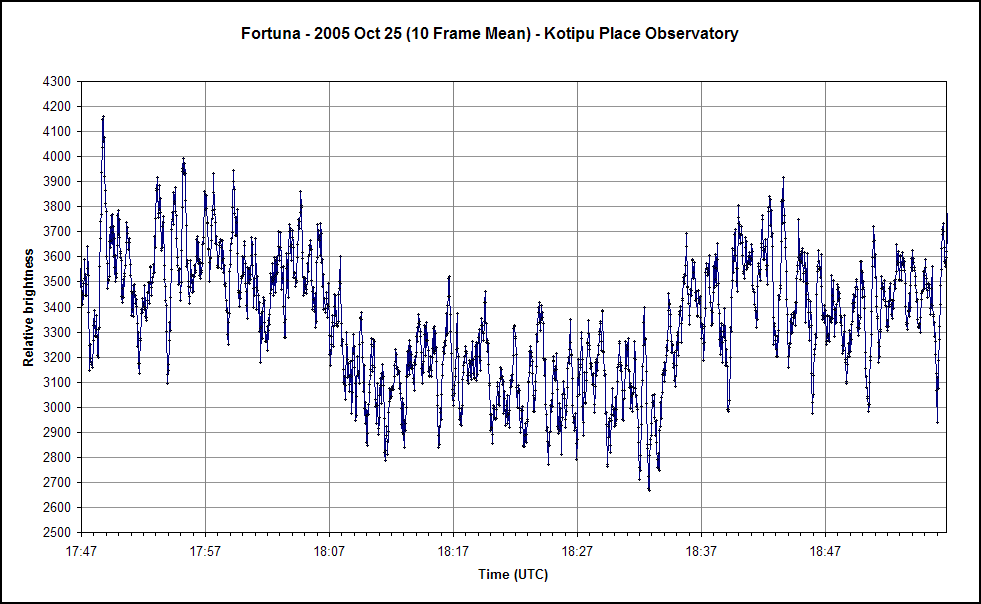
This indicates the extent of the noise, whose variation is perhaps better seen when a mean is calculated over 50 channels:
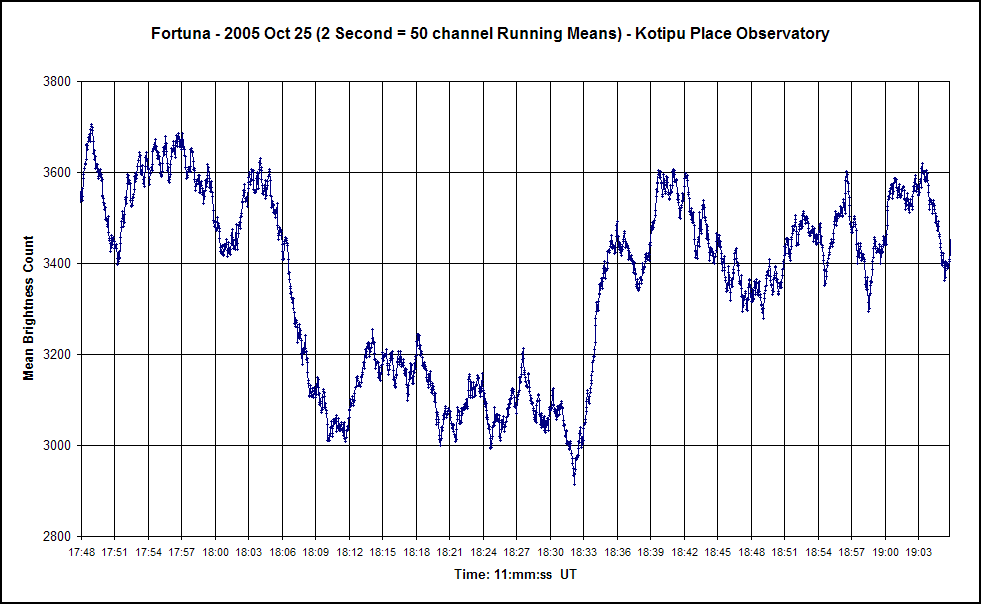
These traces show the decline (especially) and the rebrightening seem to occur over several seconds (although given the amount of noise in the data it is not possible to make a definitive statement about the reality of this). While glancing incidence of the star to the asteroid's limb would lengthen the time taken for the disappearance (owing to the lengthening of the Fresnel diffraction fringes), the angle of incidence would have to be very low indeed to achieve lengthening by such an amount. If the asteroid was more or less circular then a very low angle of incidence would imply close to a grazing event, and therefore a total occultation of quite short duration. However the observed duration of 27.4 seconds does not support this. This suggests either that the asteroid's profile is significantly non-circular or (more likely) that the perceived lengthened decline is simply part of the noise. Brian's determination of the actual magnitude drop at occultation based on the data gathered is 0.135 magnitudes.
MJUO Data:
The Mt John data was gathered at a time resolution of 0.1 seconds and is also very noisy. The event is longer than the Hudson data indicating that Mt John was closer to the centre of the path (as was to be expected from the prediction). Brian Loader calculated a running mean to extract times of geometric occultation, giving a duration of 30.0 seconds. At the time of writing however it is still to be determined how accurately the MJUO data is tied to a UTC timebase (given that there have been some problems with this in the past). If the synchronisation is not particularly good that may have the effect of sliding the Mt John chord along its length with respect to the Hudson data.
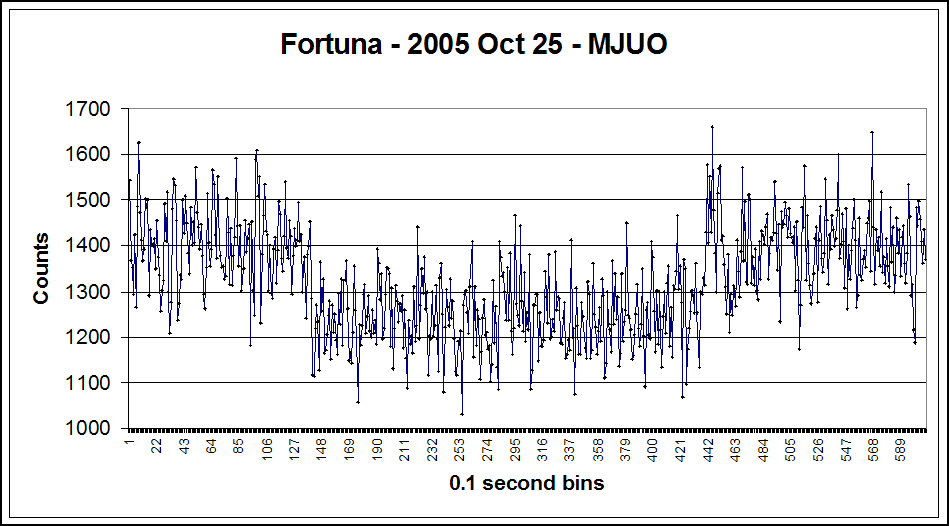
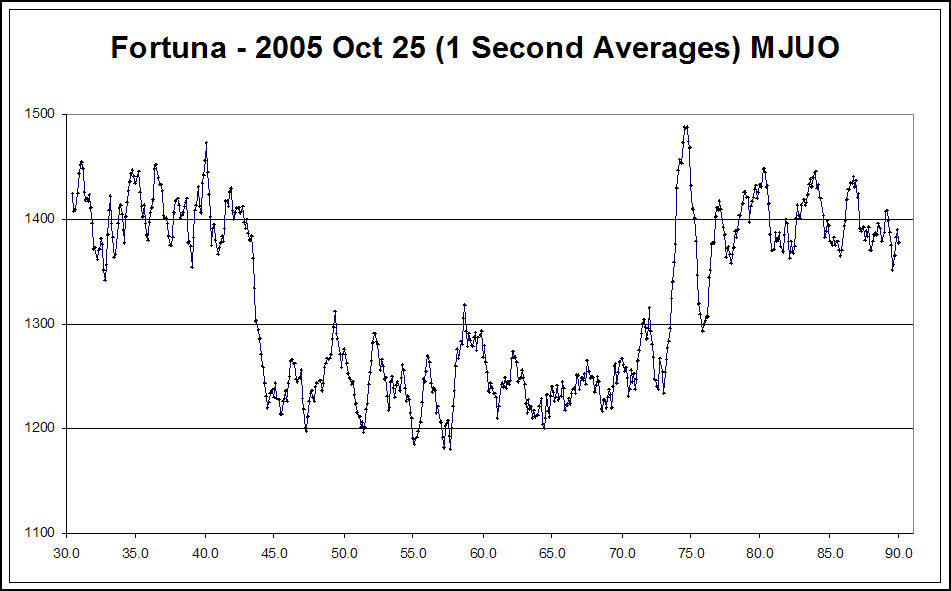
The feature on the right of the MJUO data does resembles a diffraction peak, although the very long timescale argues against this being anything other than noise.
Further Analysis:
Observers: 1 A. Gilmore, Mt John Observatory, NZ 2 G&R Hudson, Pukerua Bay, NZ 3(M?)R Wright, Wanganui, NZ (Not determined whether the data had captured an event). M = Miss
The diameter of Fortuna given in the literature varies somewhat depending on the source. Values of 221 and 124 km have been sighted. The durations reported by both the Hudsons and Gilmore clearly do not support the lower value.
The first diagram below shows the data plotted together with a circle of 221 km. (Remember that the Wanganui data is assigned zero weight as we don't know whether the event passed across there or not). Given the derived durations, and assuming that the MJUO data was correctly tied to UTC, there is a suggestion that the data does not support a circular outline. (If the MJUO data were to slide slightly then this could be more likely).
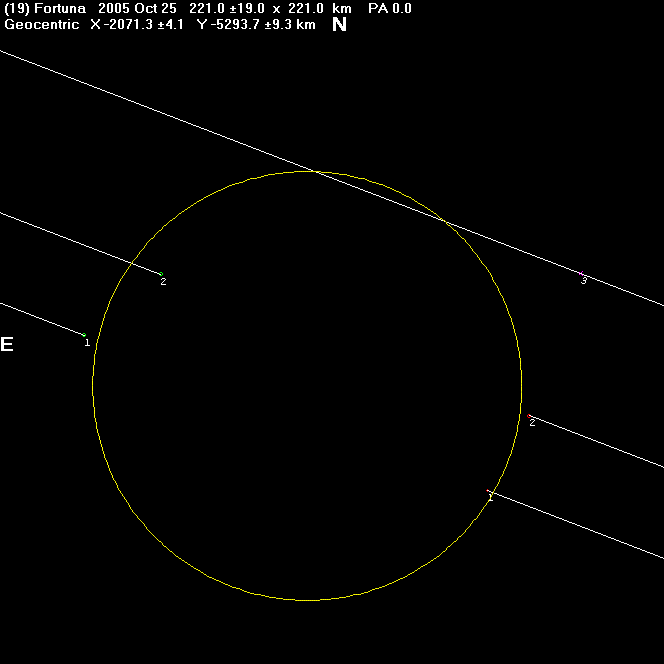
One problem however is that both that the MJUO and Kotipu Place chords are reasonably close to each other. Additionally a minimum of five well-separated data points is needed for an elliptical fit. As the diagrams below illustrate, many elliptical solutions are possible and the data is insufficient to differentiate between them. A definitive video observation from Wanganui would have resolved this.
|
|
|
Fortuna has been observed at occultation on five prior occasions, in most cases only one chord being observed. On 1983 March 11 however three visual chords were obtained:
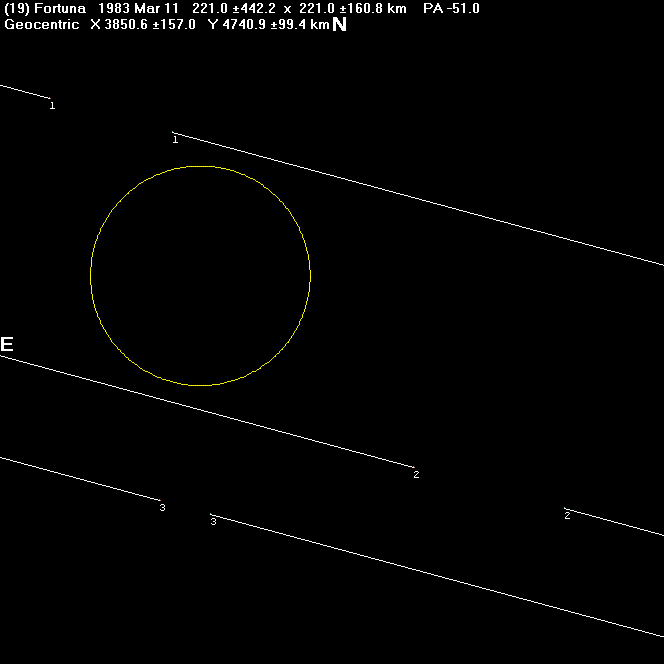
The circle is plotted at a nominal 221 km diameter. While the chords (although offset from one another) do suggest that Fortuna has a very anomalous shape, it is hard to see how the asteroid could be as thin as the above chords might imply. So there remains the possibility that the 1983 data is in error in some way, possibly through use of incorrect geographical co-ordinates.
Summary:
This event has shown the power of the video technique in being able to capture usable data from events where the magnitude drop is only ~0.1 mag. It was also an exciting event in that two non-visual data sets were captured, but the results have been necessarily limited as a further dataset is required to make any definitive statement regarding the size and shape of (19) Fortuna.
Observational Data:
Observer's Name : Rick & Gordon Hudson
Aperture (cm) :30cm
Focal length (cm) :300cm
Type (e.g. SCT; Newtonian) :Cassegrain
Magnification :Video Camera
Observing site name :KPO
Longitude (DD MM SS ; East +ve) :174E 52' 54.36"
Latitude (DD MM SS ; South -ve) :41S 02' 27.61"
Height above Sealevel (metres) :108.5 metres
Geodetic Datum (e.g.WGS84,NZ1949):NZ1949
Height Datum (if known) :
Sky Transparency (Delete two) : Clear
Star Image Stability (Delete two): Good
Other Conditions:
(Wind, Clouds, Lights, etc.):Clear & calm
Time Source (e.g. WWVH, GPS) :GPS
Recording method (e.g. tape) :Video Tape
Could you see the Asteroid? :Yes but not the star
Approx. Limiting Magnitude :12
| Estimated |
Universal Time | Reaction | Accuracy,Remarks
h m s | Time (sec) |
Started Observing : 10:50:00
Disappearance At : 11:18:07.4
Reappearance At : 11:18:34.7
Stopped Observing : 11:30:00
Duration : 27.4 sec
ADDITIONAL COMMENTS:Used video camera and recorded onto video tape with GPS timings stamped onto image frames.
Observer's Name : Alan Gilmore
Aperture (cm) : 60
Focal length (cm) : 960
Type (e.g. SCT; Newtonian) : Cassegrain
Magnification : n/a
Observing site name : Mt John University Observatory
Longitude (DD MM SS ; East +ve) : 170d 27' 51.6"
Latitude (DD MM SS ; South -ve) : -43d 59' 07.7"
Height above Sea-level (metres) : 1027
Geodetic Datum (e.g.WGS84,NZ1949): WGS84
Height Datum (if known) : MSL
Sky Transparency (Delete two) : ?
Star Image Stability (Delete two): ?
Time Source (e.g. WWVH, GPS) : ?
Recording method (e.g. tape) : Photmeter
Could you see the Asteroid? :
Approx. Limiting Magnitude :
| Estimated |
Universal Time | Reaction | Accuracy, Remarks
h m s | Time (sec) |
Disappearance At : 11:18:43.6
Reappearance At : 11:19:13.6
Duration : 30.0 seconds
Observer's Name : Ray Wright
Aperture (cm) : 25.4
Focal length (cm) : 101.6
Type (e.g. SCT; Newtonian) : Schmidt-Newtonion
Magnification : N/A
Observing site name : Brunswick
Longitude (DD MM SS ; East +ve) : 175°01'15.0" East
Latitude (DD MM SS ; South -ve) : 39°50'45.0" South
Height above Sealevel (metres) : 165
Geodetic Datum (e.g.WGS84,NZ1949): WGS 84
Height Datum (if known) :
Sky Transparency (Delete two) : Good
Star Image Stability (Delete two): Good
Time Source (e.g. WWVH, GPS) : Stopwatch (WWVH)+ Digital Video clock set to WWVH
Recording method (e.g. tape) : Video
Could you see the Asteroid? : yes
Approx. Limiting Magnitude : 11.5
| Estimated |
Universal Time | Reaction | Accuracy, Remarks
h m s | Time (sec) |
Started Observing : 11h 15’
Stopped Observing : 11h 21’
ADDITIONAL COMMENTS: I could see both the asteroid and the star and although close there was no occultation. [?]
[Top of Page][Return to Home Page]